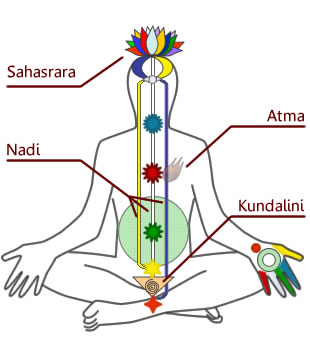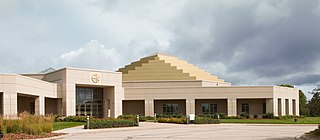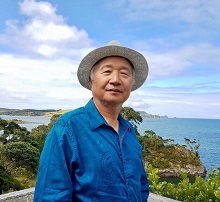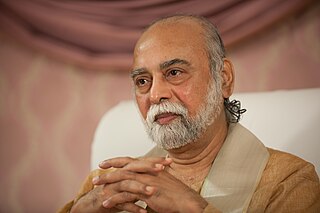Related Research Articles

Chakras are various focal points used in a variety of ancient meditation practices, collectively denominated as Tantra, or the esoteric or inner traditions of Hinduism and Buddhism.

In Hinduism, Kundalini is a form of divine feminine energy believed to be located at the base of the spine, in the muladhara. It is an important concept in Śhaiva Tantra, where it is believed to be a force or power associated with the divine feminine or the formless aspect of the Goddess. This energy in the body, when cultivated and awakened through tantric practice, is believed to lead to spiritual liberation. Kuṇḍalinī is associated with Parvati or Adi Parashakti, the supreme being in Shaktism; and with the goddesses Bhairavi and Kubjika. The term, along with practices associated with it, was adopted into Hatha yoga in the 9th century. It has since then been adopted into other forms of Hinduism as well as modern spirituality and New Age thought.

Unity is a spiritual organization founded by Charles and Myrtle Fillmore in 1889. It grew out of Transcendentalism and became part of the New Thought movement. Unity may be best known for its Daily Word devotional publication begun in 1924. Originally based in Christianity with emphasis on the Bible, Unity more recently has said it offers "positive, practical Christianity" and describes itself as "for people who might call themselves spiritual but not religious."

Radical Faeries are a loosely affiliated worldwide network and countercultural movement seeking to redefine queer consciousness through secular spirituality. Sometimes deemed a form of modern Paganism, the movement also adopts elements from anarchism and environmentalism. Rejecting hetero-imitation, the Radical Faerie movement began during the 1970s sexual revolution among gay men in the United States.

Eckankar is a new religious movement founded by Paul Twitchell in 1965. The spiritual home is the Temple of ECK in Chanhassen, Minnesota. Eckankar is not affiliated with any other religious group.

Alice Ann Bailey was a writer of more than twenty-four books on theosophical subjects, and was one of the first writers to use the term New Age. Bailey was born as Alice La Trobe-Bateman, in Manchester, England. She moved to the United States in 1907, where she spent most of her life as a writer and teacher.
Caroline Myss is an American author of 10 books and many audio recordings about mysticism and wellness. She is most well known for publishing Anatomy of the Spirit (1996). She also co-published The Creation of Health with Dr C Norman Shealy MD - ex Harvard professor of neurology. Her most recent book, Archetypes: Who Are You? was published in 2013. Myss describes herself as a medical intuitive and a mystic.

Siddha Yoga is a spiritual path founded by Swami Muktananda (1908–1982). According to its literature, the Siddha Yoga tradition is "based mainly on eastern philosophies" and "draws many of its teachings from the Indian yogic texts of Vedanta and Kashmir Shaivism, the Bhagavad Gita and the poet-saints." The present head of Siddha Yoga is Gurumayi Chidvilasananda.

Ānanda Mārga, or officially Ānanda Mārga Pracāraka Saṃgha, is a world-wide socio-spiritual organisation founded in Jamalpur, Munger, Bihar, India, in 1955 by Prabhat Ranjan Sarkar, known as Shrii Shrii Anandamurti. It is also the name of the philosophy and life-style propounded by Sarkar, described as a practical means of personal development and the transformation of society. It is established in more than 180 countries across the world. Its motto is Ātmamokśārthaṃ jagaddhitāya ca.
Georg Feuerstein was a German Indologist specializing in the philosophy and practice of Yoga. Feuerstein authored over 30 books on mysticism, Yoga, Tantra, and Hinduism. He translated, among other traditional texts, the Yoga Sutras of Patanjali and the Bhagavad Gita.
Neoshamanism refers to new forms of shamanism. It usually means shamanism practiced by Western people as a type of New Age spirituality, without a connection to traditional shamanic societies. It is sometimes also used for modern shamanic rituals and practices which, although they have some connection to the traditional societies in which they originated, have been adapted somehow to modern circumstances. This can include "shamanic" rituals performed as an exhibition, either on stage or for shamanic tourism, as well as modern derivations of traditional systems that incorporate new technology and worldviews.
David Deida is an American author who writes about the sexual and spiritual growth of men and women. His ten books have been published in 25 languages. He conducts spiritual growth and intimacy workshops and is one of the many founding associates at the Integral Institute. He has conducted research and taught classes at the University of California at Santa Cruz, Lexington Institute in Boston, San Jose State University and Ecole Polytechnique in Paris. He is the author of numerous essays, articles, and books on human spirituality including The Way of the Superior Man, Finding God Through Sex, and Blue Truth and the autobiographical novel Wild Nights.

A ganacakra is also known as tsok, ganapuja, cakrapuja or ganacakrapuja. It is a generic term for various tantric assemblies or feasts, in which practitioners meet to chant mantra, enact mudra, make votive offerings and practice various tantric rituals as part of a sādhanā, or spiritual practice. The ganachakra often comprises a sacramental meal and festivities such as dancing, spirit possession, and trance; the feast generally consisting of materials that were considered forbidden or taboo in medieval India like meat, fish, and wine. As a tantric practice, forms of gaṇacakra are practiced today in Hinduism, Bön and Vajrayāna Buddhism.
Neotantra, navatantra, or tantric sexuality is a Western new religious movement influenced by the Eastern esoteric spiritual traditions of Tantra. Rooted in elements of Hindu and Buddhist tantras, neotantra blends New Age interpretations with modern Western perspectives, often emphasizing the sexual aspects of these ancient traditions. While some proponents reference traditional texts and principles, many utilize tantra as a broader term encompassing sacred sexuality, occasionally incorporating unconventional practices. However, neotantra does not always adhere to the complete range of Indian tantric practices, particularly the reliance on a guru.

Lee Seung-Heun, better known as Ilchi Lee, is a South Korean author and the founder of a variety of mind-body training methods, including Body & Brain, Brain Wave Vibration, Kookhak Qigong, and DahnMuDo, all falling under the umbrella name "Brain Education". Lee started teaching his methods in a park in the 1980s, and since then, the practice has developed into an international network of for-profit and non-profit entities. Lee's practices have been criticized as pseudoscience, and his organizations as a cult.

Ecstatic dance is a form of dance in which the dancers, sometimes without the need to follow specific steps, release themselves to the rhythm and move freely as the music takes them, leading to trance and a feeling of ecstasy. The effects of ecstatic dance begin with ecstasy itself, which may be experienced in differing degrees. Dancers are described as feeling connected to others, and to their own emotions. The dance serves as a form of meditation, helping people to cope with stress and to attain serenity.
The Agamas are a collection of several Tantric literature and scriptures of Hindu schools. The term literally means tradition or "that which has come down", and the Agama texts describe cosmology, epistemology, philosophical doctrines, precepts on meditation and practices, four kinds of yoga, mantras, temple construction, deity worship and ways to attain sixfold desires. These canonical texts are in Tamil and Sanskrit.

Kalki Bhagawan, also known as Sri Bhagavan, is a spiritual teacher from India. He is the founder of a spiritual organization called Oneness. which has its headquarters in Varadaiahpalem, Chittoor district in Andhra Pradesh.
References
- ↑ Official Website. Retrieved 2001-08-07.
- ↑ Michael Mirdad--Walking in the Light of God-- Lecture at Unity of Sedona. Retrieved 2017-12-12.
- ↑ An Evening with Dr. Michael Mirdad. Retrieved 2011-08-07.
- ↑ Universal Lightworkers Spiritual Awakening Conference Speaker List Archived 2011-08-28 at the Wayback Machine . Retrieved 2011-08-07.
- ↑ Michael Mirdad ISTA Conference of Sexuality Consciousness on youtube.com. Retrieved 2011-08-07.
- ↑ Interview with Michael Mirdad Archived 2011-08-27 at the Wayback Machine on You Are Truly Loved, A Guide to Spiritual Awakening. Retrieved 2011-08-07.
- ↑ Michael Mirdad interview on All Considering. Retrieved 2011-08-07.
- ↑ "EVOLVE! Magazine". evolvemagazine.com. Retrieved 2017-12-13.
- ↑ Are We Gods and Goddesses? on OM Times Magazine. Retrieved 2011-08-07.
- ↑ Magazine, OMTimes (7 April 2012). "Understanding the Purpose of Life Tests - OMTimes". omtimes.com. Retrieved 2017-12-13.